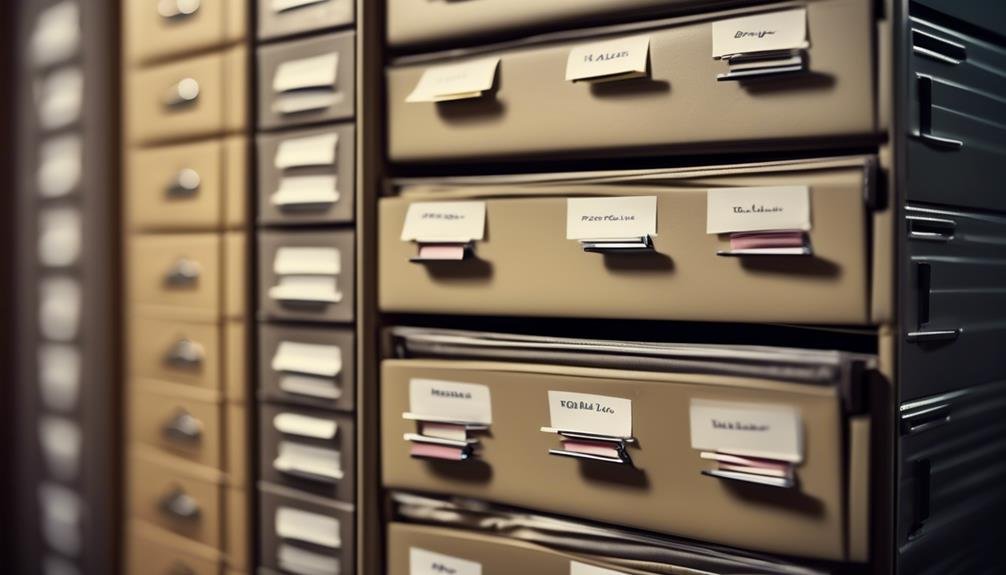Record-Keeping and Documentation Best Practices
In today's fast-paced and data-driven business environment, the importance of accurate record-keeping and documentation cannot be overstated. From legal compliance to process efficiency, maintaining comprehensive and well-organized records is crucial for the smooth operation of any organization.
However, despite its significance, many businesses struggle with establishing and maintaining effective record-keeping practices. In this discussion, we will explore the best practices for record-keeping and documentation, including the importance of standardized processes, securing sensitive information, and integrating digital tools.
By implementing these practices, organizations can not only ensure compliance but also enhance decision-making and streamline operations.
Key Takeaways
- Accurate record-keeping is crucial for maintaining organized and reliable documentation, ensuring legal compliance, financial accountability, and effective decision-making processes.
- Establishing a standardized documentation process with clear guidelines and procedures improves consistency, accuracy, and efficiency in documentation practices, promoting transparency and effective communication within the organization.
- Organizing and categorizing records effectively using a consistent filing system, physical and digital folders, and tags or metadata aids in easily locating information, ensuring compliance, and streamlining organization and retrieval of documents.
- Securing sensitive information and data through access controls, clear policies and procedures, data encryption, and regular updates to encryption keys is essential to protect personal and sensitive information and maintain data security.
Importance of Accurate Record-Keeping
Accurate record-keeping is crucial for maintaining organized and reliable documentation in any professional setting. The accuracy in documentation ensures that information is recorded correctly, providing a clear and reliable account of events, transactions, or data. This is important for various reasons, including legal compliance, financial accountability, and decision-making processes.
Maintaining data integrity is another key aspect of accurate record-keeping. Data integrity refers to the accuracy, consistency, and reliability of data throughout its lifecycle. When records are accurate, it reduces the risk of errors or discrepancies that can lead to costly mistakes or misunderstandings. It also ensures that the information can be trusted and relied upon for analysis, reporting, or auditing purposes.
Accurate record-keeping also plays a vital role in maintaining transparency and accountability. It allows for easy retrieval and verification of information, which is essential in situations where proof or evidence is required. Additionally, accurate records can provide historical context and serve as a reliable source of information for future reference.
Establishing a Standardized Documentation Process
To establish a standardized documentation process, it is essential to implement clear guidelines and procedures for recording, organizing, and storing information in a professional and efficient manner. Standardization benefits organizations by ensuring consistency, accuracy, and reliability in their documentation practices. It provides a framework for employees to follow, ensuring that all necessary information is captured and recorded in a uniform manner.
By establishing standardized documentation processes, organizations can improve documentation efficiency. Clear guidelines and procedures help employees understand the expectations and requirements for documenting information. This clarity reduces the chances of errors, omissions, or inconsistencies in the documentation.
Standardization also streamlines the organization and retrieval of information. When information is consistently recorded and organized, it becomes easier to locate and access when needed. This saves time and effort, allowing employees to focus on more critical tasks.
Furthermore, a standardized documentation process promotes transparency and accountability. It ensures that all relevant information is documented and accessible to authorized personnel. This transparency facilitates effective communication and decision-making within the organization.
Organizing and Categorizing Records Effectively
Effective organization and categorization of records is crucial for maintaining a streamlined and efficient documentation system. By implementing effective filing and document categorization practices, organizations can ensure that their records are easily accessible, properly managed, and readily available when needed.
To begin with, it is important to establish a consistent and logical filing system. This can involve using a combination of physical and digital folders, labels, and naming conventions to create a clear structure for storing and retrieving documents. By organizing records in a systematic manner, employees can quickly locate the information they need, reducing time wasted searching for misplaced or mislabeled documents.
Another key aspect of effective organization is categorizing records based on their content or purpose. This can be done through the use of tags, metadata, or specific folders dedicated to different types of documents. By categorizing records, organizations can easily distinguish between different document types, such as contracts, invoices, or employee records, making it easier to locate specific information and ensuring that documents are stored in the appropriate location.
Furthermore, implementing document categorization can also aid in compliance and regulatory requirements. By organizing records according to relevant laws and regulations, organizations can demonstrate their adherence to legal obligations and improve their ability to respond to audits or requests for information.
Securing Sensitive Information and Data
Ensuring the security of sensitive information and data is paramount in maintaining the integrity and trustworthiness of an organization's documentation system. Data privacy and data encryption are two crucial components in securing sensitive information.
Data privacy involves implementing measures to protect personal and sensitive information from unauthorized access, use, or disclosure. This can be achieved by implementing access controls, such as user authentication and authorization, to restrict access to sensitive data. Additionally, organizations should establish clear policies and procedures regarding the handling of sensitive information, including guidelines for secure storage and proper disposal.
Data encryption is another effective method for securing sensitive information. Encryption involves converting data into a code that can only be deciphered with the appropriate encryption key. This ensures that even if unauthorized individuals gain access to the data, they will not be able to understand or use it. Implementing strong encryption algorithms and regularly updating encryption keys are essential for maintaining data security.
Implementing Version Control for Document Updates
Securing sensitive information and data is crucial, and an important aspect of maintaining data integrity is implementing version control for document updates. Version control allows organizations to keep track of all changes made to a document, ensuring that the most up-to-date and accurate version is always accessible.
Here are some key benefits of implementing version control for document updates:
- Improved collaboration: Version control enables multiple team members to work on a document simultaneously, making it easier to collaborate and avoid conflicts when merging changes.
- Enhanced traceability: With version control, organizations can easily track and trace changes made to a document, including who made the changes and when.
- Increased accountability: Version control helps identify responsible parties for any mistakes or unauthorized changes, promoting accountability within the organization.
- Efficient problem-solving: In case of errors or issues, version control allows users to revert back to previous versions of a document, minimizing the impact of mistakes and facilitating problem-solving.
- Streamlined compliance: By implementing version control, organizations can ensure compliance with regulatory requirements and industry standards by maintaining a documented history of changes made to important documents.
Implementing version control for document updates is essential for maintaining data integrity, promoting collaboration, and ensuring compliance. By employing document tracking techniques like version control, organizations can enhance their record-keeping processes and improve overall data management.
Ensuring Accessibility and Retrieval of Records
To ensure the accessibility and retrieval of records, it is crucial to focus on storage and organization.
Implementing a systematic approach to categorizing and labeling records can simplify the process of locating and retrieving information when needed.
Additionally, utilizing digital record management systems can improve accessibility by providing easy search capabilities and reducing physical storage space requirements.
Lastly, establishing backup and recovery procedures is essential to safeguarding records against loss or damage, ensuring their availability in case of emergencies or technical failures.
Storage and Organization
Proper storage and organization of records is essential for ensuring easy accessibility and retrieval. When it comes to archiving methods, there are several options to consider, each with its own benefits and drawbacks. Document retention policies should also be established to determine how long records should be kept and when they can be disposed of.
Efficient filing systems allow for quick retrieval of records, reducing frustration and saving time.
Proper labeling and categorization ensure that records are easily identifiable and can be located without confusion.
Centralized storage systems streamline the process of accessing records, promoting collaboration and efficiency.
Regular maintenance and organization prevent loss or damage to important documents, reducing stress and anxiety.
Implementing digital storage solutions can enhance accessibility, enabling remote access and reducing physical storage space.
Digital Record Management
Digital record management is a crucial aspect of effective record-keeping, ensuring accessibility and retrieval of records in a streamlined and efficient manner.
With the increasing digitization of records, it is essential to adopt electronic document management systems that facilitate digital record preservation. These systems allow for the systematic organization, storage, and retrieval of digital records, eliminating the need for physical storage space and reducing the risk of loss or damage.
By implementing proper metadata tagging and indexing, digital record management systems enable quick and accurate searching, making it easier to locate specific documents when needed. Additionally, these systems often offer version control and audit trails, ensuring the integrity and authenticity of records.
Backup and Recovery
With the increasing reliance on digital record management systems, ensuring the accessibility and retrieval of records through efficient backup and recovery processes becomes paramount. To protect valuable data and ensure its availability in the event of a disaster, organizations must implement robust backup and recovery strategies.
Here are five key considerations for effective data protection and disaster recovery:
- Regular backups: Schedule routine backups to capture all changes and updates to records.
- Offsite storage: Store backup copies in a secure offsite location to safeguard against physical damage or theft.
- Testing and verification: Regularly test backup systems to ensure the integrity and completeness of the stored data.
- Documentation: Maintain detailed documentation of backup and recovery procedures for easy reference during emergencies.
- Employee training: Train employees on backup and recovery protocols to ensure they understand their roles and responsibilities in the event of a disaster.
Implementing these best practices will help organizations safeguard their records and ensure seamless accessibility and retrieval, even in the face of unexpected events.
Training Employees on Record-Keeping Best Practices
Employees can be trained on best practices for record-keeping to ensure accuracy and compliance with regulatory requirements. Training methods for effective record keeping are essential in maintaining a well-organized and efficient system.
One method is providing employees with comprehensive training sessions that cover the importance of record-keeping, the specific procedures to follow, and the regulatory requirements that need to be adhered to. This can be done through workshops, seminars, or online training modules.
Another effective training method is providing hands-on experience and guidance. Employees can be assigned a mentor or supervisor who can guide them through the record-keeping process, answer their questions, and provide feedback on their performance. This approach allows for immediate feedback and correction, ensuring that employees learn and apply best practices in real-time.
Monitoring and evaluating record-keeping practices are crucial to ensure ongoing compliance and improvement. Regular audits can be conducted to assess the quality and accuracy of records. This can involve reviewing a sample of records, checking for completeness and accuracy, and identifying any areas for improvement. Feedback from audits can be used to identify training needs and adjust training programs accordingly.
Regularly Reviewing and Auditing Records
As part of maintaining a well-organized and efficient record-keeping system, it is important to regularly review and audit records to ensure ongoing compliance and accuracy. Regularly reviewing accuracy and identifying discrepancies in records is crucial for businesses to maintain their integrity and make informed decisions based on reliable information. Here are some key reasons why regular review and audit of records is essential:
- Detecting errors: By reviewing records regularly, businesses can identify any errors or inaccuracies that may have occurred during the recording process. This allows for timely corrections and prevents further complications down the line.
- Ensuring compliance: Regular audits help ensure that records are in line with legal and regulatory requirements. This helps businesses avoid penalties and maintain their reputation.
- Enhancing efficiency: By reviewing records, businesses can identify any inefficiencies or redundancies in their record-keeping processes. This allows for streamlining and optimization, leading to improved overall efficiency.
- Identifying trends and patterns: Regularly reviewing records helps businesses identify trends, patterns, and correlations that can provide valuable insights for decision-making and strategic planning.
- Maintaining data integrity: Consistent review and audit of records help businesses maintain the integrity of their data, ensuring that information is accurate and reliable.
Integrating Record-Keeping With Digital Tools and Software
Integrating record-keeping with digital tools and software offers numerous benefits for businesses.
One key advantage is the ability to streamline the documentation process, reducing the time and effort required for record-keeping tasks.
Additionally, digital record-keeping allows for easy access, searchability, and organization of documents, enhancing efficiency and accuracy in managing records.
Digital Record-Keeping Benefits
The seamless integration of digital tools and software offers numerous benefits for effective and efficient record-keeping. With the challenges of digital record-keeping, such as data security and accessibility, the use of digital tools and software can help overcome these obstacles.
One of the key benefits is the use of cloud storage, which provides secure and reliable storage for digital records. This eliminates the need for physical storage space and reduces the costs associated with printing and paper.
In addition to cost savings, digital record-keeping also offers increased accessibility. Digital records can be accessed from anywhere at any time, allowing for easy collaboration and remote work. This enhances productivity and efficiency in the workplace.
Furthermore, digital tools and software improve organization by offering features like search and categorization. This makes it easier to organize and locate specific records, saving time and effort.
Another significant advantage of digital record-keeping is enhanced data security. With encryption and backup options, digital records are more secure compared to physical records. This ensures the safety and confidentiality of sensitive information.
Lastly, digital tools streamline workflows by automating processes and reducing manual tasks. This improves overall efficiency and productivity, allowing employees to focus on more important tasks.
Streamlining Documentation Process
To streamline the documentation process and enhance efficiency, the integration of digital tools and software with record-keeping practices is essential. By adopting digital tools and software, businesses can automate various aspects of record-keeping, reducing errors and improving productivity. Digitizing documents allows for easy organization, searchability, and accessibility, eliminating the need for manual filing and retrieval.
With the use of cloud-based storage systems, multiple users can collaborate on documents simultaneously, further streamlining the process. Additionally, digital tools enable the creation of templates and standardized formats, ensuring consistency and accuracy in documentation. Integrating digital tools with record-keeping practices also allows for real-time updates and notifications, reducing the risk of outdated or incomplete information.
Compliance With Legal and Industry Regulations
In order to ensure compliance with legal and industry regulations, it is essential for organizations to maintain meticulous record-keeping and documentation practices. Failing to comply with regulatory requirements can result in severe penalties and reputational damage.
Here are some compliance challenges that organizations face:
- Changing regulations: The regulatory landscape is constantly evolving, making it challenging for organizations to keep up with the latest requirements.
- Complexity: Compliance requirements can be complex and difficult to interpret, especially when dealing with multiple jurisdictions or industries.
- Data privacy: Organizations must navigate the complexities of data privacy regulations, such as the General Data Protection Regulation (GDPR) in the European Union, to protect sensitive customer information.
- Documentation retention: Regulatory bodies often require organizations to retain documents for a specific period. Ensuring proper retention and timely disposal of records can be a challenging task.
- Audit readiness: Organizations must be prepared for audits and inspections to demonstrate compliance. This requires maintaining accurate and up-to-date documentation.
To overcome these challenges, organizations should implement robust record-keeping and documentation practices. This includes having clear policies and procedures, training employees on compliance requirements, and leveraging technology solutions to streamline the documentation process. By prioritizing compliance and staying proactive, organizations can mitigate risks and maintain a positive reputation in their respective industries.
Conclusion
In conclusion, maintaining accurate record-keeping and documentation is crucial for organizations to ensure efficiency, compliance, and security.
By establishing standardized processes, organizing records effectively, securing sensitive information, implementing version control, training employees, regularly reviewing and auditing records, and integrating digital tools, businesses can create a solid foundation for success.
Just as a well-organized filing cabinet allows for easy access and retrieval of important documents, effective record-keeping practices pave the way for smooth operations and informed decision-making.







